Data Solutions: Analysis and Improvement of Internal Communication
VerifiedAdded on 2023/06/10
|6
|1822
|446
Report
AI Summary
This report addresses critical internal communication challenges within Data Solutions, focusing on three key problems: lack of proper communication regarding executive-level decisions, ineffective communication due to supervisors and employees working in different locations, and the sending of unprofessional emails. The report details the background and objectives of effective communication, emphasizing its importance in building strong relationships and increasing sales. It presents action steps to solve each problem, including defining the problem, identifying potential causes, brainstorming alternative approaches, selecting the best approach, planning implementation, monitoring progress, and verifying the solution's effectiveness. Proposed solutions include improving communication channels between executives and employees, restructuring the facility layout to foster closer supervisor-employee relationships, and implementing personnel training on professional email etiquette. The report concludes by highlighting the benefits of compliance, such as organizational growth, employee security, and increased productivity.
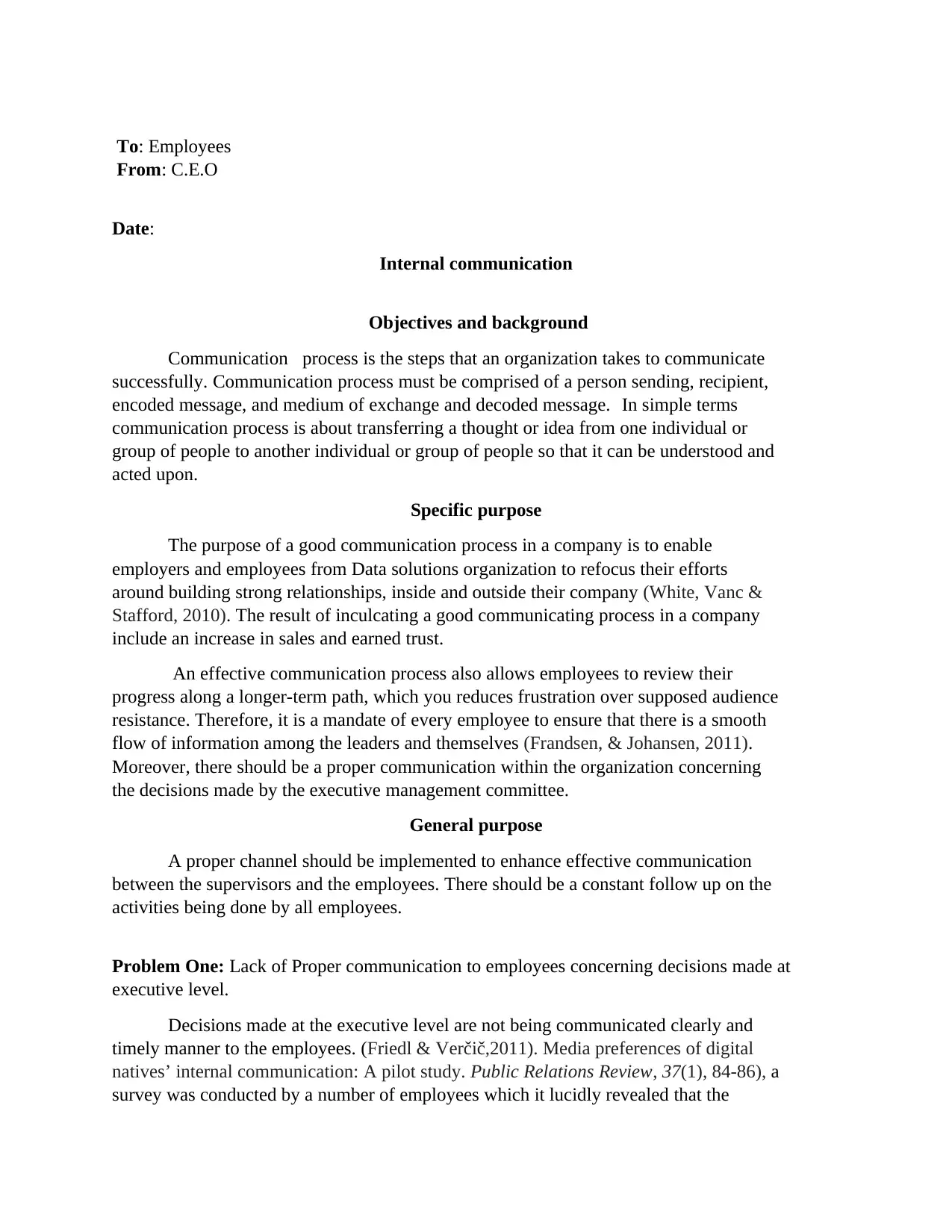
To: Employees
From: C.E.O
Date:
Internal communication
Objectives and background
Communication process is the steps that an organization takes to communicate
successfully. Communication process must be comprised of a person sending, recipient,
encoded message, and medium of exchange and decoded message. In simple terms
communication process is about transferring a thought or idea from one individual or
group of people to another individual or group of people so that it can be understood and
acted upon.
Specific purpose
The purpose of a good communication process in a company is to enable
employers and employees from Data solutions organization to refocus their efforts
around building strong relationships, inside and outside their company (White, Vanc &
Stafford, 2010). The result of inculcating a good communicating process in a company
include an increase in sales and earned trust.
An effective communication process also allows employees to review their
progress along a longer-term path, which you reduces frustration over supposed audience
resistance. Therefore, it is a mandate of every employee to ensure that there is a smooth
flow of information among the leaders and themselves (Frandsen, & Johansen, 2011).
Moreover, there should be a proper communication within the organization concerning
the decisions made by the executive management committee.
General purpose
A proper channel should be implemented to enhance effective communication
between the supervisors and the employees. There should be a constant follow up on the
activities being done by all employees.
Problem One: Lack of Proper communication to employees concerning decisions made at
executive level.
Decisions made at the executive level are not being communicated clearly and
timely manner to the employees. (Friedl & Verčič,2011). Media preferences of digital
natives’ internal communication: A pilot study. Public Relations Review, 37(1), 84-86), a
survey was conducted by a number of employees which it lucidly revealed that the
From: C.E.O
Date:
Internal communication
Objectives and background
Communication process is the steps that an organization takes to communicate
successfully. Communication process must be comprised of a person sending, recipient,
encoded message, and medium of exchange and decoded message. In simple terms
communication process is about transferring a thought or idea from one individual or
group of people to another individual or group of people so that it can be understood and
acted upon.
Specific purpose
The purpose of a good communication process in a company is to enable
employers and employees from Data solutions organization to refocus their efforts
around building strong relationships, inside and outside their company (White, Vanc &
Stafford, 2010). The result of inculcating a good communicating process in a company
include an increase in sales and earned trust.
An effective communication process also allows employees to review their
progress along a longer-term path, which you reduces frustration over supposed audience
resistance. Therefore, it is a mandate of every employee to ensure that there is a smooth
flow of information among the leaders and themselves (Frandsen, & Johansen, 2011).
Moreover, there should be a proper communication within the organization concerning
the decisions made by the executive management committee.
General purpose
A proper channel should be implemented to enhance effective communication
between the supervisors and the employees. There should be a constant follow up on the
activities being done by all employees.
Problem One: Lack of Proper communication to employees concerning decisions made at
executive level.
Decisions made at the executive level are not being communicated clearly and
timely manner to the employees. (Friedl & Verčič,2011). Media preferences of digital
natives’ internal communication: A pilot study. Public Relations Review, 37(1), 84-86), a
survey was conducted by a number of employees which it lucidly revealed that the
Paraphrase This Document
Need a fresh take? Get an instant paraphrase of this document with our AI Paraphraser
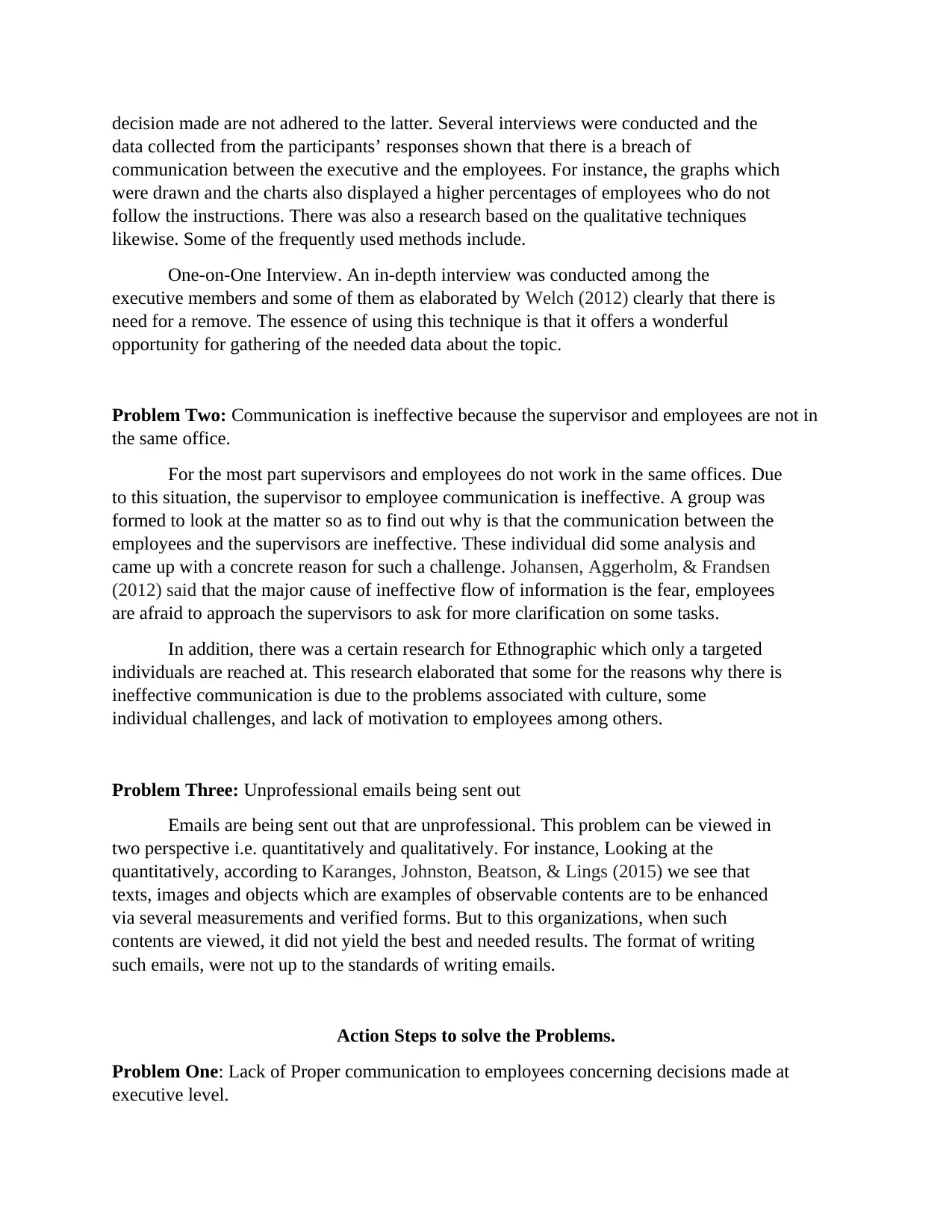
decision made are not adhered to the latter. Several interviews were conducted and the
data collected from the participants’ responses shown that there is a breach of
communication between the executive and the employees. For instance, the graphs which
were drawn and the charts also displayed a higher percentages of employees who do not
follow the instructions. There was also a research based on the qualitative techniques
likewise. Some of the frequently used methods include.
One-on-One Interview. An in-depth interview was conducted among the
executive members and some of them as elaborated by Welch (2012) clearly that there is
need for a remove. The essence of using this technique is that it offers a wonderful
opportunity for gathering of the needed data about the topic.
Problem Two: Communication is ineffective because the supervisor and employees are not in
the same office.
For the most part supervisors and employees do not work in the same offices. Due
to this situation, the supervisor to employee communication is ineffective. A group was
formed to look at the matter so as to find out why is that the communication between the
employees and the supervisors are ineffective. These individual did some analysis and
came up with a concrete reason for such a challenge. Johansen, Aggerholm, & Frandsen
(2012) said that the major cause of ineffective flow of information is the fear, employees
are afraid to approach the supervisors to ask for more clarification on some tasks.
In addition, there was a certain research for Ethnographic which only a targeted
individuals are reached at. This research elaborated that some for the reasons why there is
ineffective communication is due to the problems associated with culture, some
individual challenges, and lack of motivation to employees among others.
Problem Three: Unprofessional emails being sent out
Emails are being sent out that are unprofessional. This problem can be viewed in
two perspective i.e. quantitatively and qualitatively. For instance, Looking at the
quantitatively, according to Karanges, Johnston, Beatson, & Lings (2015) we see that
texts, images and objects which are examples of observable contents are to be enhanced
via several measurements and verified forms. But to this organizations, when such
contents are viewed, it did not yield the best and needed results. The format of writing
such emails, were not up to the standards of writing emails.
Action Steps to solve the Problems.
Problem One: Lack of Proper communication to employees concerning decisions made at
executive level.
data collected from the participants’ responses shown that there is a breach of
communication between the executive and the employees. For instance, the graphs which
were drawn and the charts also displayed a higher percentages of employees who do not
follow the instructions. There was also a research based on the qualitative techniques
likewise. Some of the frequently used methods include.
One-on-One Interview. An in-depth interview was conducted among the
executive members and some of them as elaborated by Welch (2012) clearly that there is
need for a remove. The essence of using this technique is that it offers a wonderful
opportunity for gathering of the needed data about the topic.
Problem Two: Communication is ineffective because the supervisor and employees are not in
the same office.
For the most part supervisors and employees do not work in the same offices. Due
to this situation, the supervisor to employee communication is ineffective. A group was
formed to look at the matter so as to find out why is that the communication between the
employees and the supervisors are ineffective. These individual did some analysis and
came up with a concrete reason for such a challenge. Johansen, Aggerholm, & Frandsen
(2012) said that the major cause of ineffective flow of information is the fear, employees
are afraid to approach the supervisors to ask for more clarification on some tasks.
In addition, there was a certain research for Ethnographic which only a targeted
individuals are reached at. This research elaborated that some for the reasons why there is
ineffective communication is due to the problems associated with culture, some
individual challenges, and lack of motivation to employees among others.
Problem Three: Unprofessional emails being sent out
Emails are being sent out that are unprofessional. This problem can be viewed in
two perspective i.e. quantitatively and qualitatively. For instance, Looking at the
quantitatively, according to Karanges, Johnston, Beatson, & Lings (2015) we see that
texts, images and objects which are examples of observable contents are to be enhanced
via several measurements and verified forms. But to this organizations, when such
contents are viewed, it did not yield the best and needed results. The format of writing
such emails, were not up to the standards of writing emails.
Action Steps to solve the Problems.
Problem One: Lack of Proper communication to employees concerning decisions made at
executive level.
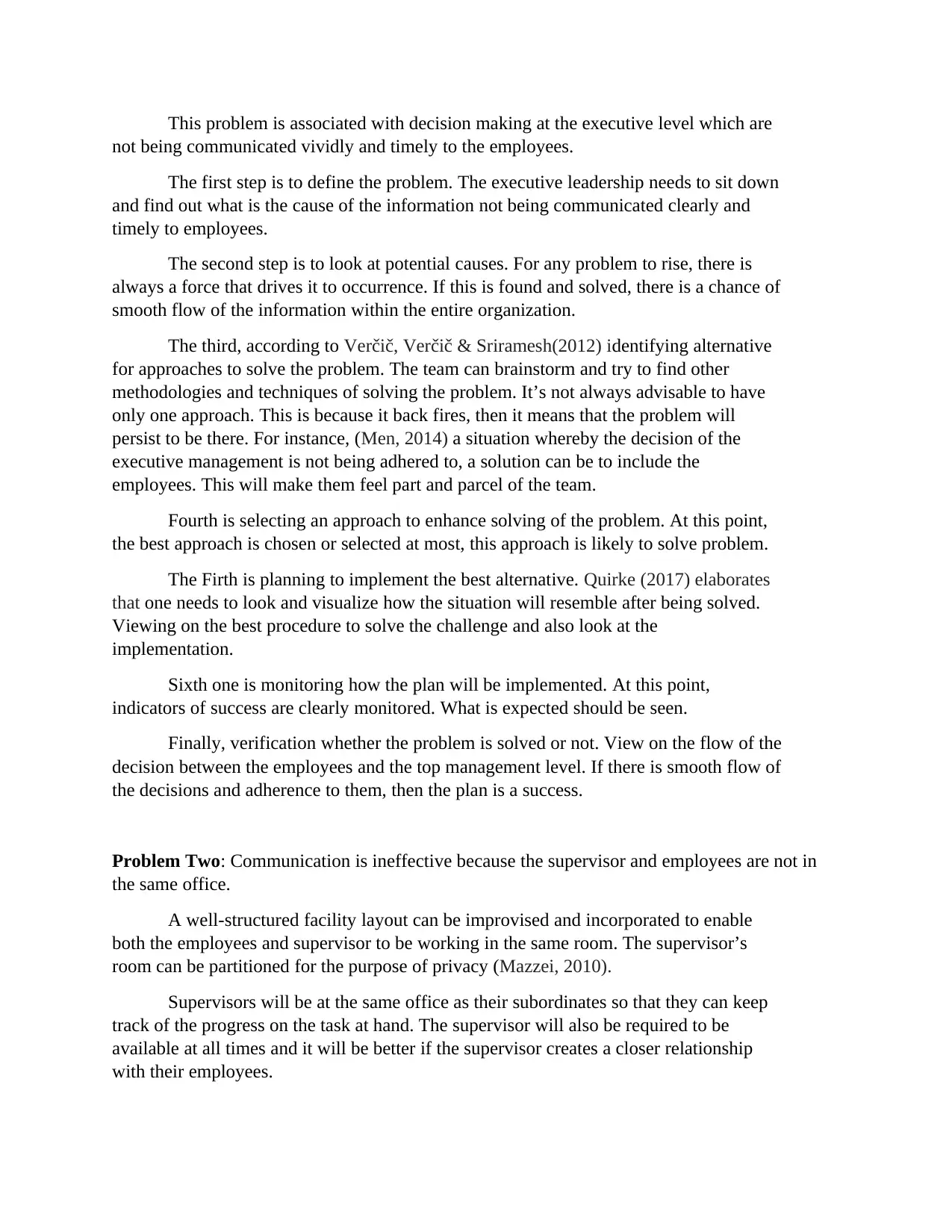
This problem is associated with decision making at the executive level which are
not being communicated vividly and timely to the employees.
The first step is to define the problem. The executive leadership needs to sit down
and find out what is the cause of the information not being communicated clearly and
timely to employees.
The second step is to look at potential causes. For any problem to rise, there is
always a force that drives it to occurrence. If this is found and solved, there is a chance of
smooth flow of the information within the entire organization.
The third, according to Verčič, Verčič & Sriramesh(2012) identifying alternative
for approaches to solve the problem. The team can brainstorm and try to find other
methodologies and techniques of solving the problem. It’s not always advisable to have
only one approach. This is because it back fires, then it means that the problem will
persist to be there. For instance, (Men, 2014) a situation whereby the decision of the
executive management is not being adhered to, a solution can be to include the
employees. This will make them feel part and parcel of the team.
Fourth is selecting an approach to enhance solving of the problem. At this point,
the best approach is chosen or selected at most, this approach is likely to solve problem.
The Firth is planning to implement the best alternative. Quirke (2017) elaborates
that one needs to look and visualize how the situation will resemble after being solved.
Viewing on the best procedure to solve the challenge and also look at the
implementation.
Sixth one is monitoring how the plan will be implemented. At this point,
indicators of success are clearly monitored. What is expected should be seen.
Finally, verification whether the problem is solved or not. View on the flow of the
decision between the employees and the top management level. If there is smooth flow of
the decisions and adherence to them, then the plan is a success.
Problem Two: Communication is ineffective because the supervisor and employees are not in
the same office.
A well-structured facility layout can be improvised and incorporated to enable
both the employees and supervisor to be working in the same room. The supervisor’s
room can be partitioned for the purpose of privacy (Mazzei, 2010).
Supervisors will be at the same office as their subordinates so that they can keep
track of the progress on the task at hand. The supervisor will also be required to be
available at all times and it will be better if the supervisor creates a closer relationship
with their employees.
not being communicated vividly and timely to the employees.
The first step is to define the problem. The executive leadership needs to sit down
and find out what is the cause of the information not being communicated clearly and
timely to employees.
The second step is to look at potential causes. For any problem to rise, there is
always a force that drives it to occurrence. If this is found and solved, there is a chance of
smooth flow of the information within the entire organization.
The third, according to Verčič, Verčič & Sriramesh(2012) identifying alternative
for approaches to solve the problem. The team can brainstorm and try to find other
methodologies and techniques of solving the problem. It’s not always advisable to have
only one approach. This is because it back fires, then it means that the problem will
persist to be there. For instance, (Men, 2014) a situation whereby the decision of the
executive management is not being adhered to, a solution can be to include the
employees. This will make them feel part and parcel of the team.
Fourth is selecting an approach to enhance solving of the problem. At this point,
the best approach is chosen or selected at most, this approach is likely to solve problem.
The Firth is planning to implement the best alternative. Quirke (2017) elaborates
that one needs to look and visualize how the situation will resemble after being solved.
Viewing on the best procedure to solve the challenge and also look at the
implementation.
Sixth one is monitoring how the plan will be implemented. At this point,
indicators of success are clearly monitored. What is expected should be seen.
Finally, verification whether the problem is solved or not. View on the flow of the
decision between the employees and the top management level. If there is smooth flow of
the decisions and adherence to them, then the plan is a success.
Problem Two: Communication is ineffective because the supervisor and employees are not in
the same office.
A well-structured facility layout can be improvised and incorporated to enable
both the employees and supervisor to be working in the same room. The supervisor’s
room can be partitioned for the purpose of privacy (Mazzei, 2010).
Supervisors will be at the same office as their subordinates so that they can keep
track of the progress on the task at hand. The supervisor will also be required to be
available at all times and it will be better if the supervisor creates a closer relationship
with their employees.
⊘ This is a preview!⊘
Do you want full access?
Subscribe today to unlock all pages.

Trusted by 1+ million students worldwide
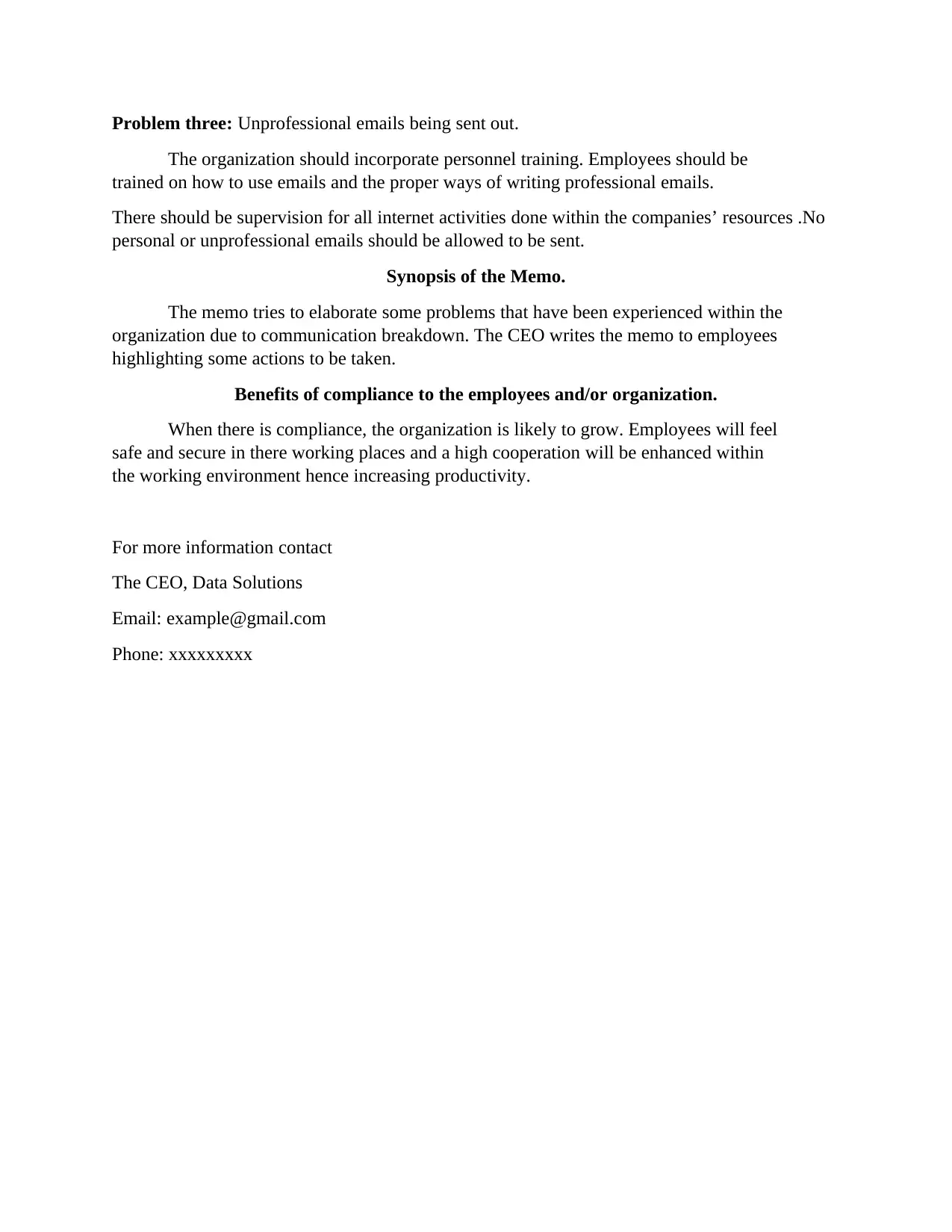
Problem three: Unprofessional emails being sent out.
The organization should incorporate personnel training. Employees should be
trained on how to use emails and the proper ways of writing professional emails.
There should be supervision for all internet activities done within the companies’ resources .No
personal or unprofessional emails should be allowed to be sent.
Synopsis of the Memo.
The memo tries to elaborate some problems that have been experienced within the
organization due to communication breakdown. The CEO writes the memo to employees
highlighting some actions to be taken.
Benefits of compliance to the employees and/or organization.
When there is compliance, the organization is likely to grow. Employees will feel
safe and secure in there working places and a high cooperation will be enhanced within
the working environment hence increasing productivity.
For more information contact
The CEO, Data Solutions
Email: example@gmail.com
Phone: xxxxxxxxx
The organization should incorporate personnel training. Employees should be
trained on how to use emails and the proper ways of writing professional emails.
There should be supervision for all internet activities done within the companies’ resources .No
personal or unprofessional emails should be allowed to be sent.
Synopsis of the Memo.
The memo tries to elaborate some problems that have been experienced within the
organization due to communication breakdown. The CEO writes the memo to employees
highlighting some actions to be taken.
Benefits of compliance to the employees and/or organization.
When there is compliance, the organization is likely to grow. Employees will feel
safe and secure in there working places and a high cooperation will be enhanced within
the working environment hence increasing productivity.
For more information contact
The CEO, Data Solutions
Email: example@gmail.com
Phone: xxxxxxxxx
Paraphrase This Document
Need a fresh take? Get an instant paraphrase of this document with our AI Paraphraser

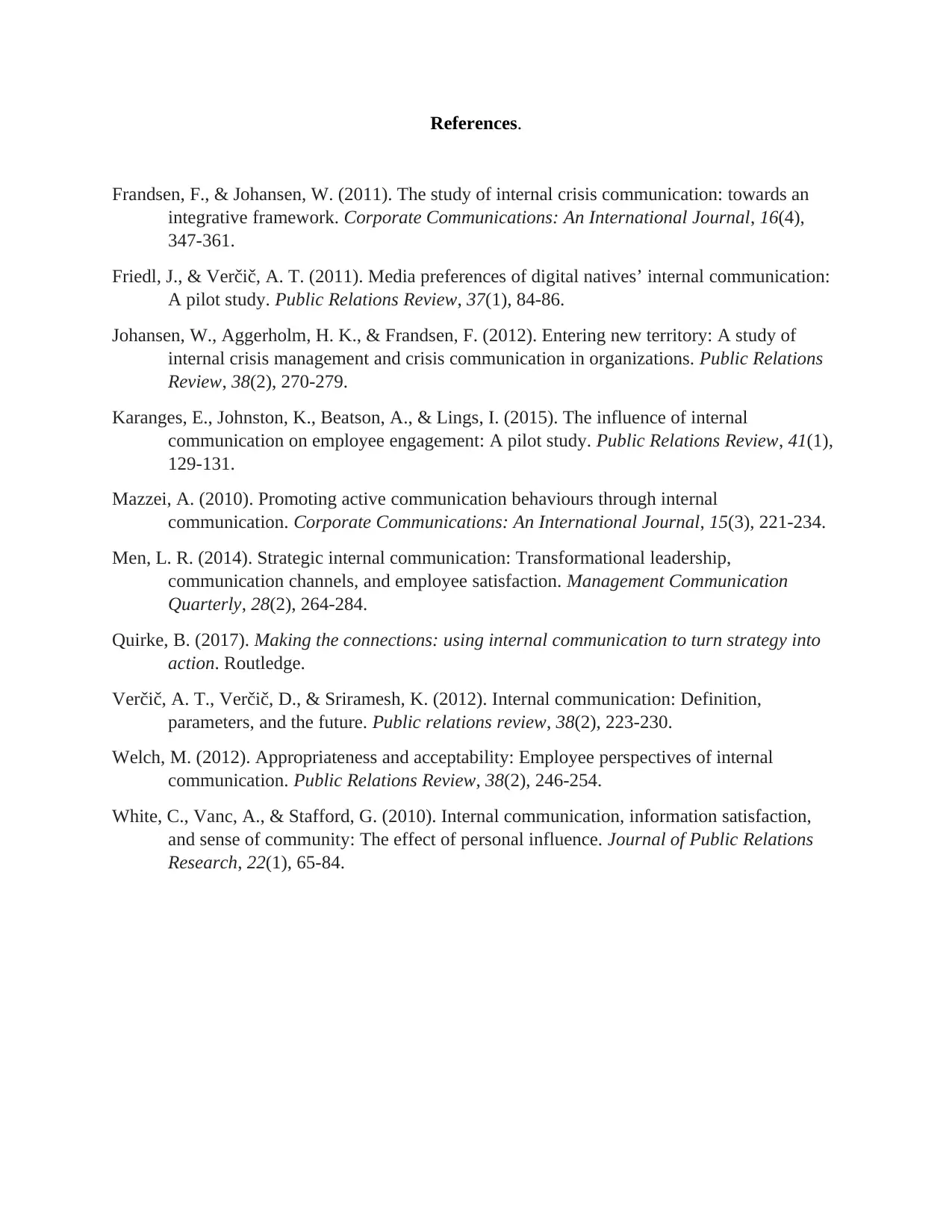
References.
Frandsen, F., & Johansen, W. (2011). The study of internal crisis communication: towards an
integrative framework. Corporate Communications: An International Journal, 16(4),
347-361.
Friedl, J., & Verčič, A. T. (2011). Media preferences of digital natives’ internal communication:
A pilot study. Public Relations Review, 37(1), 84-86.
Johansen, W., Aggerholm, H. K., & Frandsen, F. (2012). Entering new territory: A study of
internal crisis management and crisis communication in organizations. Public Relations
Review, 38(2), 270-279.
Karanges, E., Johnston, K., Beatson, A., & Lings, I. (2015). The influence of internal
communication on employee engagement: A pilot study. Public Relations Review, 41(1),
129-131.
Mazzei, A. (2010). Promoting active communication behaviours through internal
communication. Corporate Communications: An International Journal, 15(3), 221-234.
Men, L. R. (2014). Strategic internal communication: Transformational leadership,
communication channels, and employee satisfaction. Management Communication
Quarterly, 28(2), 264-284.
Quirke, B. (2017). Making the connections: using internal communication to turn strategy into
action. Routledge.
Verčič, A. T., Verčič, D., & Sriramesh, K. (2012). Internal communication: Definition,
parameters, and the future. Public relations review, 38(2), 223-230.
Welch, M. (2012). Appropriateness and acceptability: Employee perspectives of internal
communication. Public Relations Review, 38(2), 246-254.
White, C., Vanc, A., & Stafford, G. (2010). Internal communication, information satisfaction,
and sense of community: The effect of personal influence. Journal of Public Relations
Research, 22(1), 65-84.
Frandsen, F., & Johansen, W. (2011). The study of internal crisis communication: towards an
integrative framework. Corporate Communications: An International Journal, 16(4),
347-361.
Friedl, J., & Verčič, A. T. (2011). Media preferences of digital natives’ internal communication:
A pilot study. Public Relations Review, 37(1), 84-86.
Johansen, W., Aggerholm, H. K., & Frandsen, F. (2012). Entering new territory: A study of
internal crisis management and crisis communication in organizations. Public Relations
Review, 38(2), 270-279.
Karanges, E., Johnston, K., Beatson, A., & Lings, I. (2015). The influence of internal
communication on employee engagement: A pilot study. Public Relations Review, 41(1),
129-131.
Mazzei, A. (2010). Promoting active communication behaviours through internal
communication. Corporate Communications: An International Journal, 15(3), 221-234.
Men, L. R. (2014). Strategic internal communication: Transformational leadership,
communication channels, and employee satisfaction. Management Communication
Quarterly, 28(2), 264-284.
Quirke, B. (2017). Making the connections: using internal communication to turn strategy into
action. Routledge.
Verčič, A. T., Verčič, D., & Sriramesh, K. (2012). Internal communication: Definition,
parameters, and the future. Public relations review, 38(2), 223-230.
Welch, M. (2012). Appropriateness and acceptability: Employee perspectives of internal
communication. Public Relations Review, 38(2), 246-254.
White, C., Vanc, A., & Stafford, G. (2010). Internal communication, information satisfaction,
and sense of community: The effect of personal influence. Journal of Public Relations
Research, 22(1), 65-84.
⊘ This is a preview!⊘
Do you want full access?
Subscribe today to unlock all pages.

Trusted by 1+ million students worldwide
1 out of 6
Related Documents
Your All-in-One AI-Powered Toolkit for Academic Success.
+13062052269
info@desklib.com
Available 24*7 on WhatsApp / Email
![[object Object]](/_next/static/media/star-bottom.7253800d.svg)
Unlock your academic potential
Copyright © 2020–2025 A2Z Services. All Rights Reserved. Developed and managed by ZUCOL.
